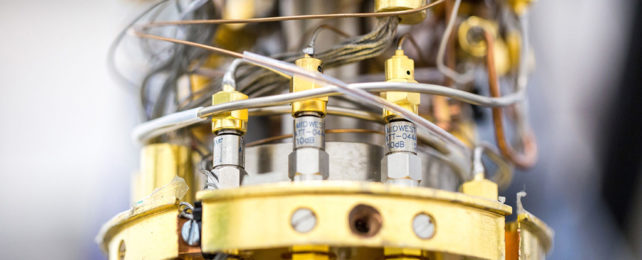Physicists Discover a New Way to ‘See’ Objects Without Looking at Them
 Part of the transmon device that produces the quantum effects used to detect microwaves without interfering with them. (Mikko Raskinen/Aalto University)
Part of the transmon device that produces the quantum effects used to detect microwaves without interfering with them. (Mikko Raskinen/Aalto University)Ordinarily, to measure an object we must interact with it in some way. Whether it’s by a prod or a poke, an echo of sound waves, or a shower of light, it’s near impossible to look without touching.
In the world of quantum physics, there are some exceptions to this rule.
Researchers from Aalto University in Finland propose a way to ‘see’ a microwave pulse without the absorption and re-emission of any light waves. It’s an example of a special interaction-free measurement, where something is observed without being rattled by a mediating particle.
The fundamental concept of ‘looking without touching’ isn’t new. Physicists have shown it’s possible to use the wave-like nature of light to explore spaces without evoking its particle-like behavior by splitting neatly aligned waves of light through different paths and then comparing their journeys.
Instead of lasers and mirrors, the team used microwaves and semiconductors, making it a separate achievement. The setup used what’s known as a transmon device to detect an electromagnetic wave pulsed into a chamber.
While relatively large by quantum standards, these devices mimic the quantum behavior of individual particles on multiple levels using a superconducting circuit.
“The interaction-free measurement is a fundamental quantum effect whereby the presence of a photosensitive object is determined without irreversible photon absorption,” write the researchers in their published paper.
“Here we propose the concept of coherent interaction-free detection and demonstrate it experimentally using a three-level superconducting transmon circuit.”
The team relied on the quantum coherence produced by their bespoke system – the ability for objects to occupy two different states at the same time, like Schrödinger’s cat – in order to make the complex setup successful.
“We had to adapt the concept to the different experimental tools available for superconducting devices,” says quantum physicist Gheorghe Sorin Paraoanu, from Aalto University in Finland.
“Because of that, we also had to change the standard interaction-free protocol in a crucial way: we added another layer of quantumness by using a higher energy level of the transmon. Then, we used the quantum coherence of the resulting three-level system as a resource.”
The experiments run by the team were backed up with theoretical models confirming the results. It’s an example of what scientists call the quantum advantage, the ability for quantum devices to go beyond what’s possible with classical devices.
In the delicate landscape of quantum physics, touching things is akin to breaking them. Nothing ruins a neat wave of probability like the crunch of reality. For cases where detection needs a more gentle touch, alternative methods of sensing – like this one – could come in handy.
Areas in which this protocol can be applied include quantum computing, optical imaging, noise detection and cryptographic key distribution. In each case, the efficiency of the systems involved would be significantly improved.
“In quantum computing, our method could be applied for diagnosing microwave-photon states in certain memory elements,” says Paraoanu. “This can be regarded as a highly efficient way of extracting information without disturbing the functioning of the quantum processor.”
The research has been published in Nature Communications.